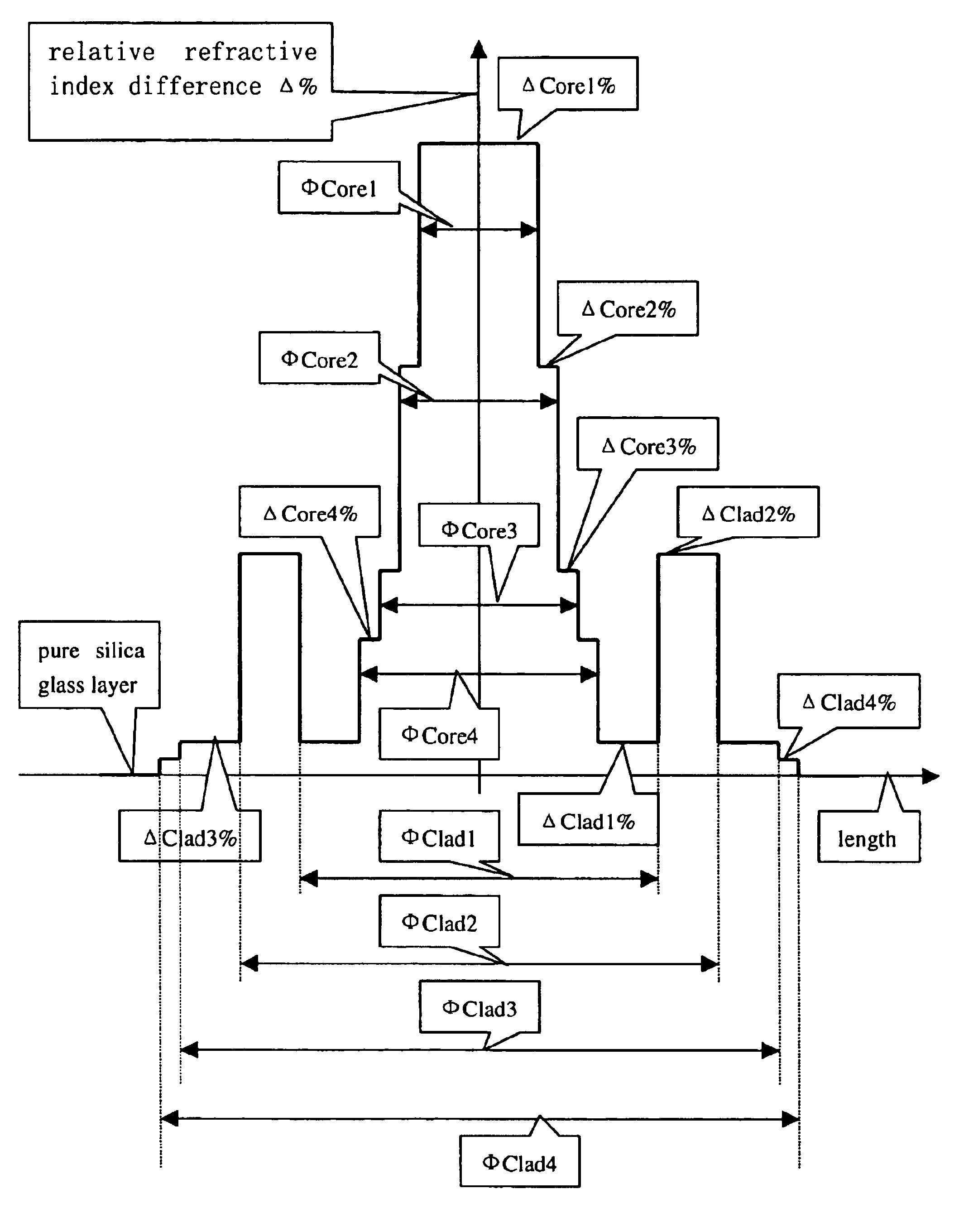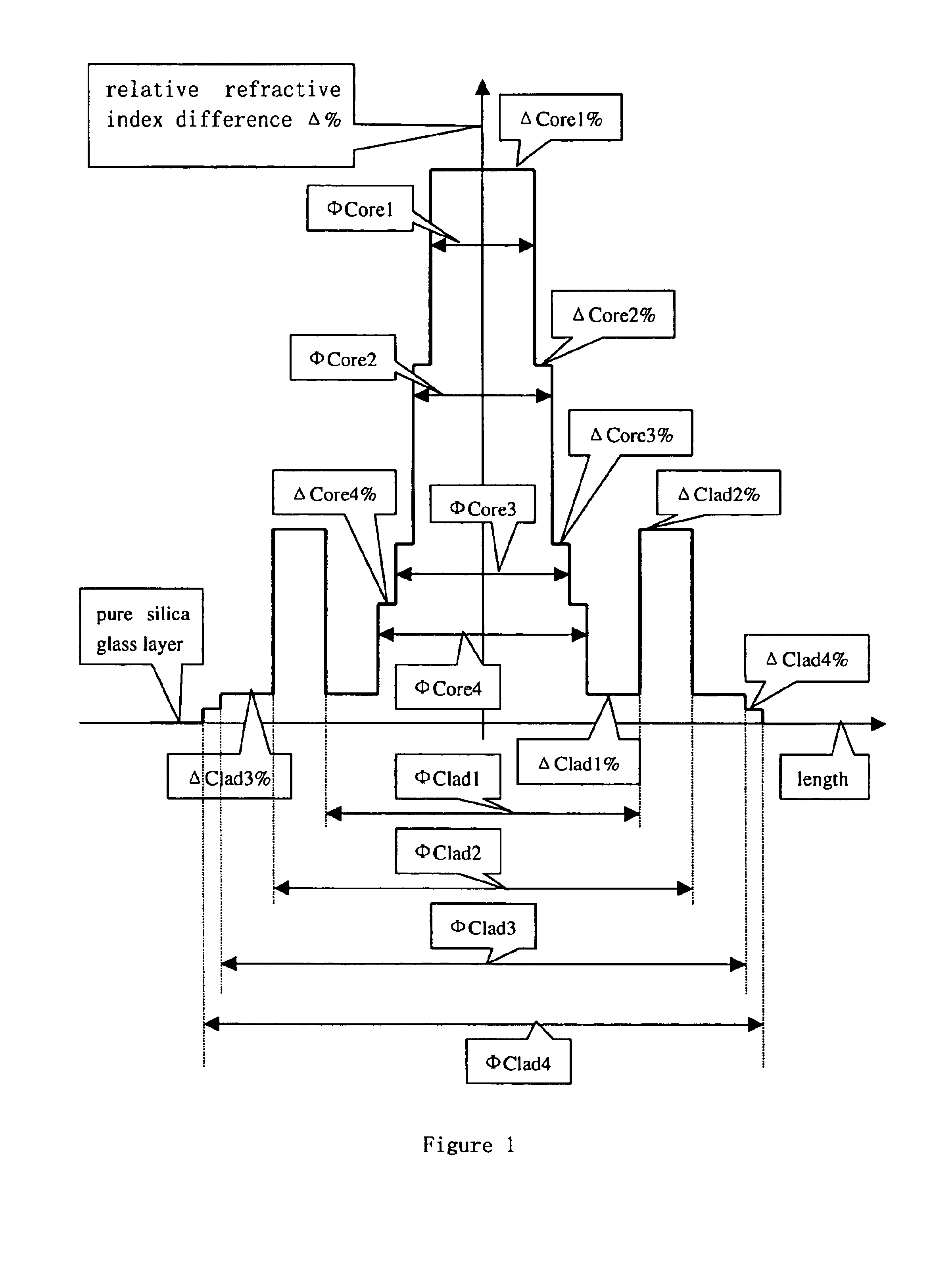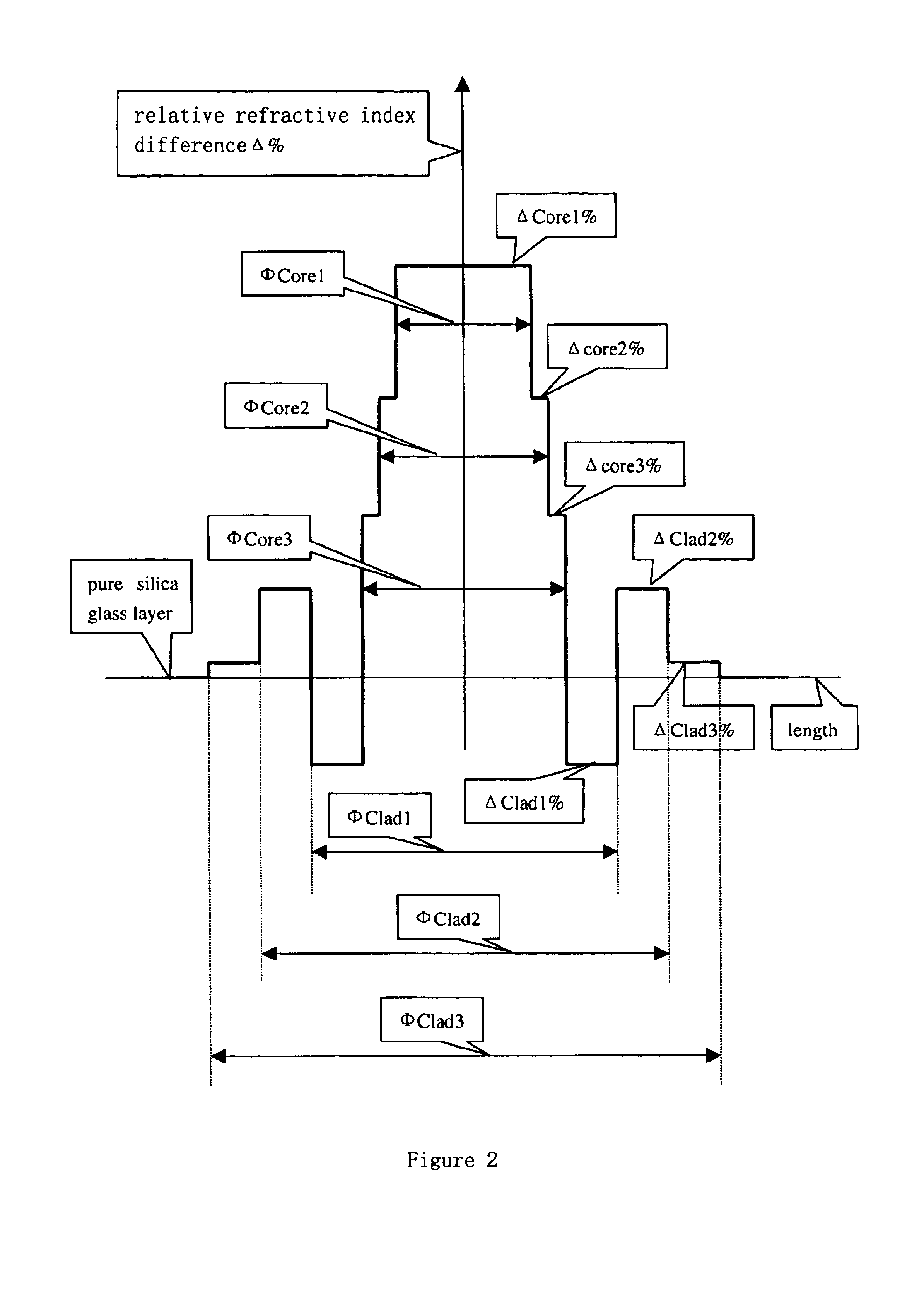Dispersion-shifted single-mode fiber having low dispersion slope for large capacity transmission
a single-mode fiber and large-capacity technology, applied in the field of single-mode fibers, can solve the problems of limiting the augmenting of system capacity, s-band cannot be used for dwdm transmission, and inability to obtain complete compensation in side-band regions, etc., to achieve easy equilibration of dispersion slope, effective area and attenuation performance of fibers, and control the performance of fibers more precisely
- Summary
- Abstract
- Description
- Claims
- Application Information
AI Technical Summary
Benefits of technology
Problems solved by technology
Method used
Image
Examples
embodiment 1
[0033
[0034]The parameter set for relative refractive index difference profiles shown in FIG. 1 are listed as follows:
[0035]The parameters of the respective core segments are:
[0036]First core segment Core1:[0037]ΔCore1% is about 0.64, ΦCore1 is about 3.0 μm
[0038]Second core segment Core2:[0039]ΔCore2% is about 0.42, ΦCore2 is about 4.1 μm
[0040]Third core segment Core3:[0041]ΔCore3% is about 0.21, ΦCore3 is about 7.5 μm
[0042]Fourth core segment Core4:[0043]ΔCore4% is about 0.15, ΦCore4 is about 9.0 μm
[0044]The parameters of the respective cladding segments are:
[0045]First cladding segment Clad1:[0046]ΔClad1% is about 0.04, ΦClad1 is about 15.0 μm
[0047]Second cladding segment Clad2:[0048]ΔClad2% is about 0.25, ΦClad2 is about 21.0 μm
[0049]Third cladding segment Clad3:[0050]ΔClad3% is about 0.04, ΦClad3 is about 27.0 μm
[0051]Fourth cladding segment Clad4:[0052]ΔClad4% is about 0.02, ΦClad4 is about 31.0 μm
[0053]The outmost cladding segment is a pure silica glass layer.
[0054]The performa...
embodiment 2
[0064
[0065]The parameter set for relative refractive index difference profiles shown in FIG. 2 are listed as follows:
[0066]The parameters of the respective core segments are:
[0067]First core segment Core1:[0068]ΔCore1% is about 0.42, ΦCore1 is about 4.6 μm
[0069]Second core segment Core2:[0070]ΔCore2% is about 0.35, ΦCore2 is about 6.0 μm
[0071]Third core segment Core3:[0072]ΔCore3% is about 0.28, ΦCore3 is about 7.1 μm
[0073]The parameters of the respective cladding segments are:
[0074]First cladding segment Clad1:[0075]ΔClad1% is about −0.10, ΦClad1 is about 11.5 μm
[0076]Second cladding segment Clad2:[0077]ΔClad2% is about 0.18, ΦClad2 is about 16.2 μm
[0078]Third cladding segment Clad3:[0079]ΔClad3% is about 0.02, ΦClad3 is about 29.0 μm
[0080]Fourth cladding segment is a pure silica glass layer.
[0081]The performances of the obtained fiber are the follows:
[0082]Effective area at 1550 nm: 64 μm2,
[0083]Zero-dispersion wavelength: 1395 nm,
[0084]Dispersion at 1550 nm: 7.4 ps / nm·km,
[0085]Di...
embodiment 3
[0091
[0092]The fiber of Embodiment 3 has two negative relative refractive index differences in its cladding segments. The parameter set for said relative refractive index difference profiles shown in FIG. 3 are listed as follows:
[0093]The parameters of the respective core segments are:
[0094]First core segment Core1:[0095]ΔCore1% is about 0.42, ΦCore1 is about 4.6 μm
[0096]Second core segment Core2:[0097]ΔCore2% is about 0.35, ΦCore2 is about 6.0 μm
[0098]Third core segment Core3:[0099]ΔCore3% is about 0.28, ΦCore3 is about 7.1 μm
[0100]The parameters of the respective cladding segments are:
[0101]First cladding segment Clad1:[0102]ΔClad1% is about −0.08, ΦClad1 is about 12.5 μm
[0103]Second cladding segment Clad2:[0104]ΔClad2% is about 0.18, ΦClad2 is about 18.1 μm
[0105]Third cladding segment Clad3:[0106]ΔClad3% is about −0.08, ΦClad3 is about 29.0 μm
[0107]Fourth cladding segment is a pure silica glass layer.
[0108]The performances of the obtained fiber are the follows:
[0109]Effective are...
PUM
 Login to View More
Login to View More Abstract
Description
Claims
Application Information
 Login to View More
Login to View More - R&D
- Intellectual Property
- Life Sciences
- Materials
- Tech Scout
- Unparalleled Data Quality
- Higher Quality Content
- 60% Fewer Hallucinations
Browse by: Latest US Patents, China's latest patents, Technical Efficacy Thesaurus, Application Domain, Technology Topic, Popular Technical Reports.
© 2025 PatSnap. All rights reserved.Legal|Privacy policy|Modern Slavery Act Transparency Statement|Sitemap|About US| Contact US: help@patsnap.com



